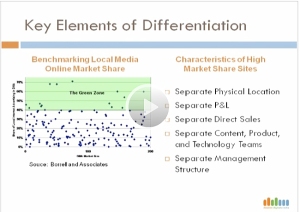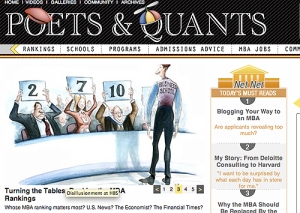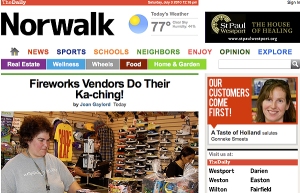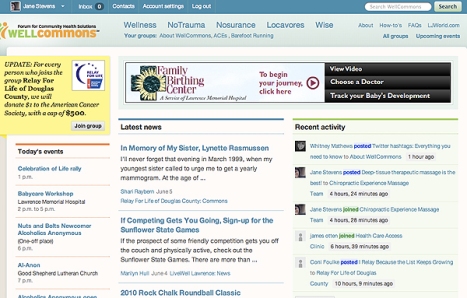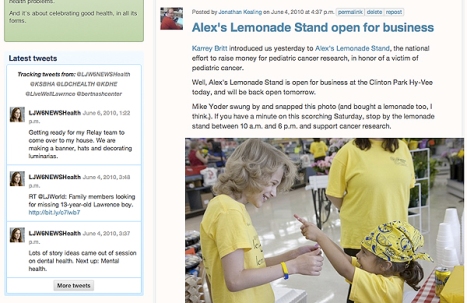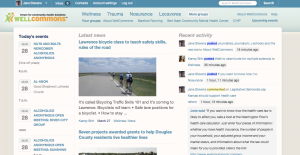[A version of this appears on News Leadership 3.0, the Knight Digital Media Center blog on innovation, transformation and news leadership.]
Last week, WellCommons, a local health news site, part of the Lawrence Journal-World in Lawrence, KS, won Editor & Publisher’s EPPY award for “Best Community Service on a Media-Affiliated Website with under 250,000 unique monthly visitors”. Thank you, judges!
Since there wasn’t an article about the winners, just a list, I’ll explain why we nominated WellCommons and why I think it’s a proof-of-concept for nearly everything that Clay Shirky, Jay Rosen and Jeff Jarvis have been preaching.
We bulldozed the barriers between community and journalists. We tore down the wall between the newsroom and advertising. We jettisoned the old print advertising model. Reporters changed how they did their work. The role of journalism changed. We also established a solution-oriented environment and planned to add tools to further strengthen continuity and context.
Remember that phrase from the Clinton campaign? “It’s the economy, stupid!” Well, in the case of the wrenching transition that journalism’s going through…It’s the basic structure, stupid!
Much of journalism is stuck in the quicksand of trying preserve the print or TV or radio platform on a very different digital medium that has its own idiosyncrasies. The main difference between WellCommons and any other news site is that social media is baked into the DNA of its content management system. It IS a social media site.
As a friend put it: WellCommons “let the people in!” That changes everything. Everything! More than we realized.
The site launched in beta in April 2010; the 2.0 version was launched in March 2011. Here are the basics:
1. Anyone in the community can post content directly into the WellCommons news stream. That includes text, video, photos, graphics. People have to use their real names. There’s no editing by WellCommons staff, no moderation prior to publishing. Most of this content is further fed into the news stream on LJWorld, the news organization’s central site.
As Marilyn Hull, who runs LiveWell Lawrence, a local project of the Douglas County Community Foundation, noted: “…it puts us in the driver’s seat. I used to send news releases to the paper, and they seldom resulted in stories. Now, we don’t have editors deciding what is newsworthy. We get to post our news, and then our community can decide if it is worth reading.”
In other words, this structure efficiently captures “the long tail” of health news and information in Lawrence – the information that’s always useful to some part of the community but that reporters, who focus on content that reaches bigger chunks of the community, don’t have time to get to.
2. The site is built around groups rather than blogs. Why? One, groups solve communities’ problems. Two, this structure gives people two points of reference to judge the information — the person who posts the content and the group page to which they post the content.
3. We involve the community. Really. About four months prior to launch, an advisory group of 25 to 30 people met regularly with Lawrence Journal-World staff to provide input and review. Their suggestions figured heavily in how the site looks and functions. The group, comprising members that rotate on and off, continues to meet and provide great advice. Why not. It’s their site.
4. A new ad model. Yep, there are banner ads, but that’s not where the site derives most of its revenue. Most comes from sponsorship. Potentially, a good chunk can come from businesses that provide health products and services, many of which would never consider advertising in print or in LJWorld.com. Since they’re a vital part of the local health community (so says our community) businesses can set up their own group pages; they pay to do so. They participate just like the rest of the community – the content they post to their group pages shows up in the news stream. The site also has potential to derive significant revenues from events.
5. We integrated all parts of the news organization. Reporters, editors, advertising reps, marketing executives, technology developers and social media managers met weekly and communicated daily. We shared information about what we were doing and what events were coming up that we could work on together. The reporter gave the ad rep business leads, the marketing exec gave the reporter story leads. We cheered the ad reps for each business they signed up. Before I left the organization in September, we talked about including a community rep. Although our community advisory group meets a few times a year, and members of the community are encouraged (and do…often) tell us what they want from the site, it would be even more useful if someone sat in on our weekly meetings.
6. The plan: create a network of local niche sites. Our vision was to go with the flow of the developing digital news ecosystem — thousands of niche sites aggregated into networks. KUSports, Lawrence.com, WellCommons and SunflowerHorizons currently feed into LJWorld.com. In the grand scheme, we planned on using the same CMS and approach to create local business, outdoor recreation, and education niche sites. LJWorld would become the aggregator and focus breaking news. The staff to support such an organization is lean – one or two reporters per niche site, a small breaking news team, and a social media CMS that integrates the community.
7. Changing the conversation of health. WellCommons takes a community-based approach to health reporting. Most health sites focus on personal health — what individuals can do to improve their own or their families’ health. But at a local level, health is a community issue. Our kids are supposed to eat healthy food, but if school lunch programs provide mac-and-cheese, French fries and few vegetables, then improving kids’ nutrition is a community issue. We’re all supposed to exercise, but if a community doesn’t have enough safe places to walk, jog, bike and play outdoors, then creating those facilities is the responsibility of the community. Over the last two years, the basic conversation about health has shifted toward a community solution-oriented approach. And there’s a lot more conversation. Our goal was 10 posts a day, with half coming from the community.
Here are 10 headlines from two days in December. All are generated by the local health community – 6 from LJWorld/WellCommons reporters, 4 from members of the WellCommons community, including Kansas Health Service.
Kansas overall health ranking drops
VIDEO: event to celebrate growth, new partnerships, transformed lives
Spring girls family-based sexuality education class now enrolling
Did you get a flu shot this year?
Kansas Medicaid makeover part of a nationwide trend
Kansas ranks last in making progress on children’s health insurance
For Santa Bob, giving keeps him going
Health officials urge residents to get flu shot before holidays hit
Classic heart attack symptoms often absent in women
In doing a cursory look at other local news organization health sites — if they even have a local health site — it’s a veritable desert compared with the Manhattan of WellCommons.
8. WellCommons ain’t finished. To achieve context and continuity, it needs topic pages (community- and reporter-curated, with timelines). To achieve another level of solution-oriented content, it needs a goals application for community groups (e.g., the localvore community wants to facilitate the planting of 100 new vegetable gardens). For just plain ease, it needs a calendar system in which people can follow each other’s calendars. And of course it needs a mobile app.
What we learned from creating WellCommons, is that journalism’s role in this new digital medium is to create a safe place and a trusted source for the community to solve its problems. The Lawrence community is telling us that we’re making a good start with WellCommons. That’s a good thing.
Based on my experience with WellCommons, I returned to California in October to lay the foundation to set up a network of local health sites, and to set up a national news network focused on child trauma prevention and trauma-informed care; the focus of that network is ACEsTooHigh.com.
Addendum: After planning to set up a network of local social journalism health sites, I decided that every community in the world needed to learn about, and integrate practices based on, the science of adverse childhood experiences, about which I had been reporting since 2005. So, I created ACEs Connection, comprising ACEsTooHigh.com, a news site for the general public, and ACEsConnection.com, a social journalism health site. ACEsConnection.com is hosted on a white-label social network run by Social Strata.
Filed under: Uncategorized | 3 Comments »



